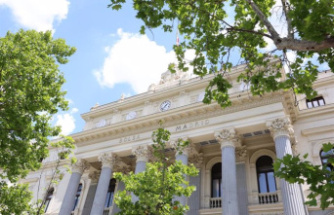The global transportation of goods is mainly routed, to 90%, by the oceans. This sector accounts for approximately 3 % of the total global emissions of greenhouse gases, without taking account of the releases of sulphur dioxide and fine particles. It would be responsible for 60,000 premature deaths in Europe, according to a survey of 2015 from the university of Rostock. A figure that could be increased because the activity is expected to increase from 50% to 250% by 2050, according to the scenarios of the International Maritime Organization (IMO). Against this global scourge, the players in France are mobilizing to revive the cargo to sailing. This eco-friendly solution is particularly effective in that it reduces by 90 % the emissions of CO2.
one of The sailing boats used by TOWT to transport goods by sea without leaving any carbon footprint. TOWT"charters of the existing boats, capable of carry 10, 200, or 300 tons of goods," asserts Guillaume Le Grand, president of the society of maritime transport Towt, for TransOceanic Wind Transport, which specialises in trips to the veil. The company, established in 2009, is based on a fleet of four old ships measuring from 20 to 40 meters to reach England, Portugal, Scandinavia and across the Atlantic.
To distinguish and value the goods transported to the air force, the group created the label Anemos (which means "wind" in ancient Greek). This logo is used on products that are also branded, each, of a number of travel. "We set the path of the product and its carbon footprint, in full transparency. We offer full traceability to consumers who may also know of what co-op come from cocoa beans, for example," says William The Great.
chocolate bars, packets of coffee, bottles of rum, tea bags... are transported and labelled. The products are then sold via the online shop of Towt or live in his store, situated in Douarnenez in Brittany. Especially, the start-up carries products for other groups, such as the brand shops of organic products Biocoop for the Portuguese wine, beer, or olive oil. The idea appeals to restaurateurs, retailers, or even large groups of the Cac 40. "We offer a practical solution to companies who wish to reduce their carbon footprint and meet the expectations of consumers in this area", adds the founder of the structure which has achieved last year a turnover of 300,000 euros (339.772 dollars).
"In 2016, we carried 120 tons of products, and then 180 tons in 2017 and 220 tonnes in the past year," commented the officer. The company has saved 300 tonnes of greenhouse gas emissions. "It is still low, but we are the only ones to propose numbers that were neutral in maritime transport. We did our part," says Guillaume Le Grand.
Even if the activity grows, it remains in effect as a drop of water compared to the 10.5 billion tons of cargo have been transported on more than 5,000 container ships in the past year. However, the leader believes that his concept is validated and that the solution is economically viable. According to his calculations, the cargo wing has a cost slightly higher than the conventional transport. As a result, products are sold a bit more expensive, for example around 10 euro-cents more per bottle of wine," says Guillaume Le Grand.
cargo ships to sail innovative soon on the oceanson the strength of its model, the contractor sees greater. It is engaged in the construction of a sailing ship modern. The future three-masted sailing ship which would take the sea at the end of 2021 will measure 67 metres and will be capable of transporting 1 000
tons of goods, with a cruising speed of 11 knots. It will be thus two times faster than the old sailing ships now chartered by Towt and sail at a speed similar to that of the cargo of pollutants current. "Once in the water, the sail Cargo ship will save more than 10,000 tonnes of CO2 per year and more than 300,000 tonnes over its life", calculates William The Great.
"once in the water, the sail Cargo ship will save more than 10,000 tonnes of CO2 per year and more than 300,000 tonnes over the duration of its life."
Towt is not the only group to invest on a cargo ship to sail. The French company Grain of Sail, which manufactures and markets chocolate and coffee, has launched the construction of a vessel which, twice a year, will cross the Atlantic to sail to bring back up to 35 tonnes of cargo. In addition, the Nantes Neoline, which develops cargo sail ships and drive wind goes even further. At the end of the year, the start-up has signed a three-year partnership with Renault to transport vehicles to the islands of Saint-Pierre-and-Miquelon, to the south of the canadian island of Newfoundland in North America. This agreement provides for the construction of two cargo ships, type ro, 136 metres long, propelled by sail to cross the Atlantic and boost the cargo to sailing. This solution is a way for the automaker to achieve its goal of reducing its carbon footprint by 25 % between 2010 and 2022.
It's a safe bet that the area of the cargo for sailing to continue its development. In fact, in the past year, the International Maritime Organization announced the signing of an agreement aimed at reducing "at least 50 % of" the CO2 emissions from maritime transport by 2050 compared to the level of 2008. Use the force of the wind to reduce CO2 emissions, as well as the pollution of air and oceans, remains the most effective solution... The sector, however, must invent a new economic model.
This article is published in the framework of Earth Beats, an international initiative and collaborative, bringing together 18 of the world's media, including Figaro Tomorrow , around solutions to waste and pollution.
Le Figaro
Company, health, environment, education, energy
" check out the actors and initiatives of change
Date Of Update: 29 April 2019, 00:00












